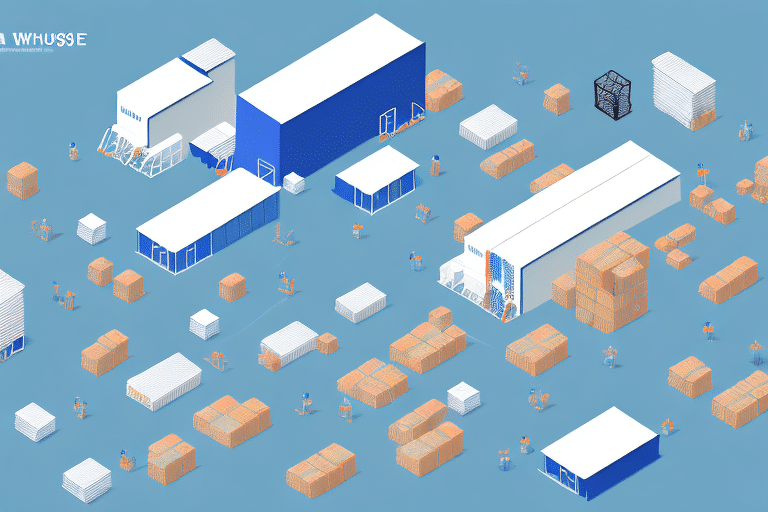Optimizing Inventory Flow for Maximum Efficiency
Running a successful business requires more than just selling a great product or service. One critical component of any business operation is inventory flow management. Ensuring that your inventory flows smoothly and efficiently throughout your company can make a substantial difference in your bottom line. In this article, we will discuss the importance of optimizing inventory flow and provide strategies for improving your inventory management practices.
Why Optimizing Inventory Flow is Critical for Businesses
Effective inventory flow management is essential because it creates a more efficient, cost-effective, and profitable business. Efficient inventory flow allows businesses to manage their stock levels more accurately and use their resources more efficiently. Companies that optimize their inventory flow can minimize waste, reduce carrying costs, and improve their customer experience by ensuring the products they are looking for are always in stock.
Another benefit of optimizing inventory flow is that it can help businesses stay competitive in their industry. By having a better understanding of their inventory levels and demand, companies can make more informed decisions about pricing and promotions. This can help them attract and retain customers, as well as increase their market share.
Furthermore, optimizing inventory flow can also lead to better relationships with suppliers. When businesses have a clear understanding of their inventory needs, they can communicate more effectively with their suppliers and negotiate better terms. This can result in cost savings and improved delivery times, which can ultimately benefit the business and its customers.
Understanding the Basics of Inventory Flow Management
Inventory flow management is the process of managing goods as they move through a company's supply chain. The inventory flow begins with the procurement of raw materials and ends with the delivery of finished products to customers. Managing inventory flow effectively requires careful planning, organization, and execution. This process involves controlling inventory levels, rationalizing product lines, and identifying and reducing waste. Inventory flow is a complex process, and understanding it is essential to optimizing it.
One of the key challenges in inventory flow management is balancing the costs of holding inventory with the risks of stockouts. Holding too much inventory can tie up capital and increase storage costs, while holding too little can result in lost sales and dissatisfied customers. To strike the right balance, companies use various inventory management techniques such as just-in-time (JIT) inventory, economic order quantity (EOQ), and safety stock. These techniques help companies optimize their inventory levels and ensure that they have the right amount of inventory at the right time.
Analyzing the Current Inventory Flow in Your Business
To optimize your inventory flow, you must first analyze your current inventory management practices. This involves examining your current inventory levels, production schedules, and order fulfillment processes. You should also evaluate your supplier network, logistical processes, and your current technology systems. By analyzing your current inventory flow, you can identify areas that need improvement and start developing strategies for optimizing your inventory management practices.
One important aspect to consider when analyzing your inventory flow is the demand for your products. By understanding the demand patterns, you can adjust your inventory levels accordingly and avoid stockouts or overstocking. This can be achieved through data analysis and forecasting techniques.
Another factor to consider is the cost of holding inventory. By analyzing your inventory flow, you can identify slow-moving or obsolete items and take action to reduce their inventory levels. This can help you free up valuable warehouse space and reduce the costs associated with holding excess inventory.
Identifying Bottlenecks in Your Inventory Flow
To optimize your inventory flow, you need to identify the bottlenecks that are slowing down your production process. These bottlenecks could exist in any part of the supply chain. Common bottlenecks include slow-moving inventory, long lead times, and overstocked warehouses. Once you have identified the bottlenecks, you can develop strategies to alleviate them and improve your inventory flow management.
One way to identify bottlenecks is to analyze your inventory data. Look for patterns in inventory levels, order fulfillment times, and production delays. This data can help you pinpoint where the bottlenecks are occurring and what is causing them.
Another strategy is to involve your team in the process. Ask for feedback from employees who work directly with inventory and production. They may have insights into areas that could be improved or streamlined. By involving your team, you can create a culture of continuous improvement and collaboration.
Strategies for Reducing Inventory Waste and Increasing Efficiency
Reducing inventory waste is an essential component of optimizing your inventory flow. Strategies for reducing waste include:
- Implementing a just-in-time (JIT) inventory system
- Using predictive analytics to improve demand forecasting
- Streamlining order fulfillment processes
These strategies can help ensure that your inventory levels are always optimized, and your production process runs smoothly.
Another effective strategy for reducing inventory waste is to conduct regular audits of your inventory levels. By regularly reviewing your inventory, you can identify slow-moving or obsolete items and take action to reduce their quantities or remove them from your inventory altogether. Additionally, implementing a barcode or RFID tracking system can help you keep better track of your inventory levels and reduce the risk of overstocking or stockouts.
Implementing an Automated Inventory Management System
Implementing an automated inventory management system is one of the most effective ways to optimize your inventory flow. By automating your inventory management process, you can reduce the risk of human error, improve accuracy, and speed up inventory processing time. These systems can provide real-time data and analytics, which can help you make more informed decisions and optimize your inventory flow management practices.
Another benefit of implementing an automated inventory management system is that it can help you save time and money. With automated systems, you can easily track inventory levels, monitor stock levels, and reorder products when necessary. This can help you avoid stockouts and overstocking, which can lead to lost sales and increased costs.
Furthermore, automated inventory management systems can help you streamline your supply chain management. By automating the process of ordering and receiving inventory, you can reduce the time and effort required to manage your inventory. This can help you focus on other important aspects of your business, such as marketing and sales, and ultimately improve your bottom line.
Tips for Streamlining Your Supply Chain and Reducing Lead Times
Streamlining your supply chain and reducing lead times is essential to optimizing your inventory flow. Strategies for reducing lead times include:
- Using more efficient transportation methods
- Improving supplier communication
- Using technology to improve order tracking and delivery times
By streamlining your supply chain and reducing lead times, you can improve the flow of goods through your business and increase customer satisfaction.
Another strategy for reducing lead times is to implement a just-in-time (JIT) inventory system. This system involves ordering and receiving goods only when they are needed, rather than keeping excess inventory on hand. This can help reduce the amount of time goods spend in transit and in storage, ultimately reducing lead times and improving inventory flow.
It's also important to regularly review and analyze your supply chain processes to identify areas for improvement. This can involve conducting regular audits of suppliers, tracking delivery times and order accuracy, and seeking feedback from customers. By continuously improving your supply chain processes, you can further streamline your operations and reduce lead times, ultimately improving your bottom line.
The Role of Data Analysis in Optimizing Inventory Flow
Data analysis is a critical component of optimizing your inventory flow. By analyzing your data, you can identify trends, forecast demand, and optimize inventory levels. You can also use data analysis to identify areas that need improvement, such as slow-moving inventory or overstocked warehouses. By using data to inform your decision-making processes, you can make more informed decisions and improve your inventory flow management practices.
Furthermore, data analysis can also help you identify opportunities for cost savings and increased efficiency. By analyzing your inventory data, you can identify which products have the highest profit margins and adjust your inventory levels accordingly. You can also identify which suppliers offer the best prices and delivery times, allowing you to make more informed purchasing decisions. By optimizing your inventory flow through data analysis, you can reduce costs and improve your bottom line.
Common Challenges in Optimizing Inventory Flow and How to Overcome Them
Optimizing inventory flow is not without its challenges. Common challenges include:
- Inaccurate demand forecasting
- Poor inventory visibility
- Inefficient logistical processes
Overcoming these challenges requires a comprehensive understanding of your supply chain and the implementation of effective strategies that address these issues.
Best Practices for Maintaining an Efficient Inventory Flow
Maintaining an efficient inventory flow involves implementing best practices that are specific to your business needs. These practices should include:
- Managing demand forecasting
- Optimizing inventory levels
- Streamlining order fulfillment processes
- Implementing supply chain partnerships with reliable suppliers
Measuring the Success of Optimized Inventory Flow with Key Performance Indicators (KPIs)
Measuring the success of optimized inventory flow is essential to ensuring continuous improvement. Key performance indicators (KPIs) such as:
- Inventory turnover rate
- Carrying cost of inventory
- Order fulfillment times
can help you assess the effectiveness of your inventory flow management practices. These KPIs should be regularly monitored to identify areas that require improvement and to track progress over time.
Case Studies of Successful Inventory Flow Optimization in Different Industries
There are numerous case studies of successful inventory flow optimization in various industries. For example, McMaster-Carr, a supplier of industrial and commercial equipment, optimized its inventory flow using a just-in-time inventory system. This system dramatically increased its inventory turnover rate and reduced waste, resulting in significant cost savings. By studying successful case studies, you can gain insight into effective inventory flow management strategies and adapt them to your business.
Future Trends in Inventory Flow Optimization and How to Stay Ahead of the Curve
The field of inventory flow optimization is constantly evolving, and it's essential to stay up-to-date with the latest trends and technologies. Some of the future trends in inventory flow optimization include:
- The use of blockchain technology to improve supply chain transparency
- The integration of artificial intelligence (AI) to improve demand forecasting
- The use of robotics to automate inventory management processes
By keeping abreast of these trends, you can stay ahead of the curve and optimize your inventory flow management practices.
Conclusion: The Importance of Continuous Improvement in Achieving Maximum Efficiency in Inventory Flow Management
Optimizing your inventory flow is essential to achieving maximum efficiency in your business. By employing effective inventory management practices, you can minimize waste, reduce carrying costs, and improve customer satisfaction. However, optimization is an ongoing process that requires continuous improvement and adaptation. By staying informed of emerging trends and continuously monitoring your KPIs, you can optimize your inventory flow management practices and ensure that your business remains competitive and successful for years to come.




















